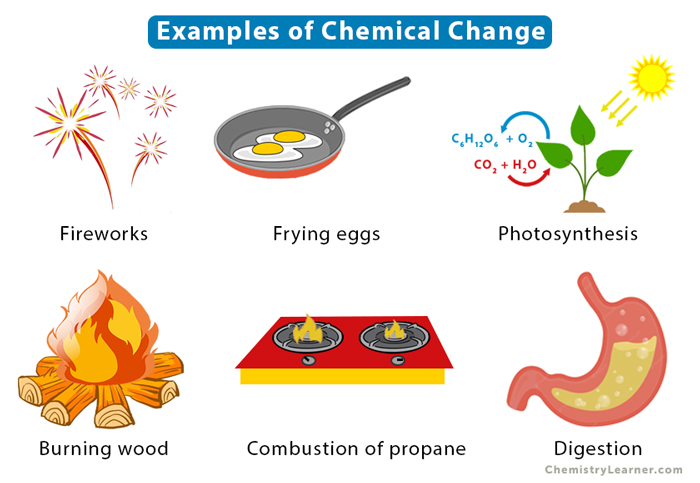Chemical Change
A chemical change is a chemical reaction involving the rearrangement of atoms and the formation of new substances with chemical properties different from the starting substances. An example of a chemical change is the rusting of iron, in which iron and oxygen combine to form iron oxide. Unlike a physical change, a chemical change cannot be reversed except by a further chemical reaction [1-4].
Types and Examples of Chemical Change [1-4]
Inorganic Change
An inorganic change does not involve carbon. In other words, carbon is not present in the reactants nor solely as a solid compound.
Examples
1. Acid-base reaction or neutralization reaction
Sodium hydroxide (NaOH) reacts with hydrochloric acid (HCl) to produce sodium chloride (NaCl) and water (H2O).
NaOH (aq.) + HCl (aq.) → NaCl (aq.) + H2O (l)
Fireworks contain metal nitrites. When ignited, they burst into flames and produce light and heat through a redox reaction.
Other examples include oxidation and reduction reactions.
Organic Change
An organic change involves carbon. Carbon may be present as a reactant or a part of the reactants’ compositions. All organic compounds have carbon in them.
Examples
1. Combustion of natural gas is a perfect example. Natural gas, like methane and propane, consists of carbon. When combusted in the presence of oxygen, it gives carbon dioxide and water.
The combustion reaction of propane is written as follows:
C3H8 (g) + 5 O2 (g) → 3 CO2 (g) + 4 H2O (l)
2. Frying an egg is a chemical change. The egg molecules get energy from the heat supplied to the fryer. The liquid in the egg (egg white) is converted into a solid. Proteins from the yolk are transformed into other proteins.
Other reactions include polymerization, condensation, fermentation (sour milk), methylation, and halogenation. Reactions occurring in the petrochemical, pharmaceutical, and cosmetic industries are organic changes.
Biochemical Change
A biochemical change occurs in living organisms through many complex reactions. These reactions are generally initiated by complex proteins known as enzymes.
Examples
1. Photosynthesis is a typical example. During photosynthesis, plants take energy from the Sun and convert carbon dioxide and water into sugar and oxygen.
6 CO2 (g) + 6 H2O (l) → C6H12O6 (s) + O2 (g)
2. Digestion converts chemical energy from food into mechanical energy that enables the body to perform work.
Other examples include the decomposition of organic matter and photosynthesis.
Signs of Chemical Change
A chemical change can be recognized by the following indicators [1-4]:
1. Change in Temperature
A chemical change accompanies a change in energy. Since a chemical change involves energy, there can also be a temperature change. The change is exothermic if heat is given off during the reaction. When heat is absorbed, it is called an endothermic reaction. For example, a thermite reaction is accompanied by a temperature increase (exothermic).
2. Change in Color
An example of color change in a chemical reaction is rusting. Rusting occurs when iron reacts with oxygen in the presence of moisture to form reddish-brown iron (III) oxide, commonly known as rust.
3. Noticeable Odor
When two substances react or when a substance decomposes and produces a distinct odor, it indicates a chemical change. For example, the decomposition of an egg gives a foul smell.
4. Formation of Precipitate
The formation of a precipitate is the most common sign of a chemical change. A precipitate is a solid that forms during a chemical reaction and does not go into the solution. It either settles at the bottom or remains suspended. For example, when the aqueous salt of silver (I) nitrate combines with sodium chloride salt solution, a white precipitate of silver(I) chloride forms.
5. Formation of Bubbles
Bubble formation is also an indicator of a chemical change. It is generally accompanied by temperature change. For example, the reaction between sodium carbonate and hydrochloric acid results in the formation of carbon dioxide gas, which is observed as bubbles.
FAQs
Ans. A chemical change cannot break down an atom.





